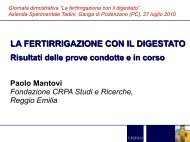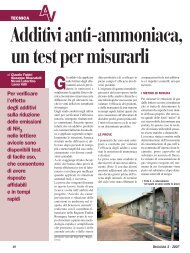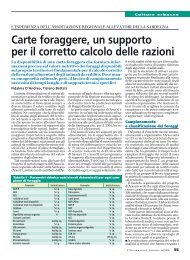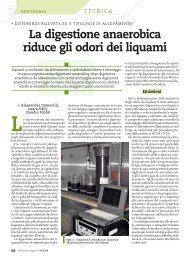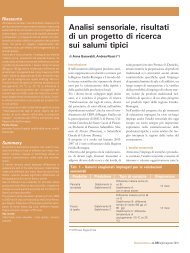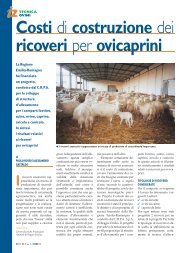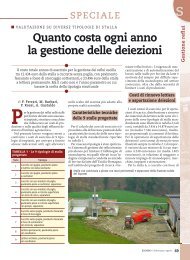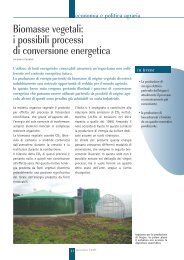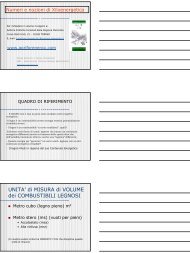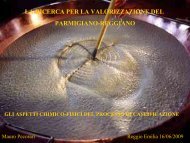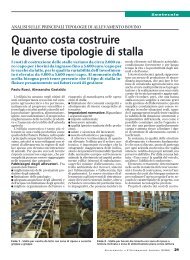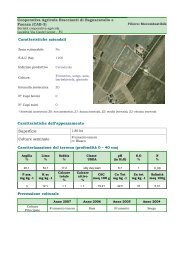Quale futuro per i produttori di latte in Italia? - Centro Ricerche ...
Quale futuro per i produttori di latte in Italia? - Centro Ricerche ...
Quale futuro per i produttori di latte in Italia? - Centro Ricerche ...
Create successful ePaper yourself
Turn your PDF publications into a flip-book with our unique Google optimized e-Paper software.
20<br />
IL PROGETTO INNOVALATTE 2030<br />
– le <strong>di</strong>sposizioni riguardanti gli aspetti ambientali, <strong>di</strong> benessere degli animali,<br />
<strong>di</strong> salubrità, salute e sicurezza alimentare, formulate a livello <strong>di</strong><br />
Unione europea e implementate dagli Stati membri, ai quali spetta,<br />
<strong>per</strong>altro, il compito <strong>di</strong> eseguire i controlli e sanzionare le <strong>in</strong>adempienze.<br />
A tutto ciò si aggiunge un ulteriore elemento da non trascurare e cioè<br />
gli <strong>in</strong>terventi della politica agricola nazionale, che <strong>in</strong> <strong>Italia</strong> sono con<strong>di</strong>visi<br />
tra Stato e Regioni. Rientrano <strong>in</strong> questa categoria il sistema delle agevolazioni<br />
(contributive, fiscali, previdenziali, ecc.) e i classici <strong>in</strong>terventi <strong>di</strong><br />
politica agraria (misure <strong>di</strong> mercato e strutturali) a completamento e <strong>in</strong>tegrazione<br />
<strong>di</strong> quelli realizzati dall’Unione europea tramite la PAC.<br />
La PAC, le regole che sovr<strong>in</strong>tendono al WTO e la politica ambientale<br />
sono oggetto <strong>di</strong> cont<strong>in</strong>ui ed importanti cambiamenti, i quali si riflettono<br />
sulle con<strong>di</strong>zioni <strong>di</strong> funzionamento della filiera lattiero-casearia, andando<br />
a impattare sulle <strong>per</strong>formance delle aziende, sulla struttura e sull’organizzazione<br />
del settore e sulle con<strong>di</strong>zioni nelle quali si svolge la competizione.<br />
Per esempio, dal 1991 al 2008 si sono susseguite ben quattro <strong>di</strong>verse<br />
riforme della PAC, che hanno cambiato i connotati dell’<strong>in</strong>tervento pubblico<br />
europeo sul settore agricolo. Un qu<strong>in</strong>to ciclo riformatore è <strong>in</strong>iziato<br />
nel 2009 ed oggi è <strong>in</strong> pieno svolgimento: la nuova PAC sarà applicata nel<br />
<strong>per</strong>iodo <strong>in</strong>tercorrente tra il 2014 e il 2020.<br />
Di seguito, vengono approfon<strong>di</strong>te le misure e il budget previsti dalla<br />
PAC <strong>per</strong> le aziende da <strong>latte</strong>; <strong>per</strong> questo settore la PAC ricopre un ruolo importante,<br />
con una spesa nel triennio 2007-2010 che è stata <strong>in</strong> me<strong>di</strong>a ogni<br />
anno <strong>di</strong> 3,5 miliar<strong>di</strong> <strong>di</strong> euro, <strong>in</strong> calo rispetto al <strong>per</strong>iodo precedente, e pari<br />
a circa 26 euro <strong>per</strong> ogni tonnellata <strong>di</strong> <strong>latte</strong> prodotto.<br />
Senza entrare nello specifico delle s<strong>in</strong>gole misure, esse si articolano <strong>in</strong>:<br />
– misure <strong>di</strong> mercato (quote <strong>di</strong> produzione, prezzi <strong>di</strong> <strong>in</strong>tervento, acquisto<br />
e stoccaggio delle eccedenze, protezione alle frontiere), il cui scopo è <strong>di</strong><br />
sostenere il prezzo sul mercato europeo al <strong>di</strong> sopra <strong>di</strong> quello che si determ<strong>in</strong>erebbe<br />
<strong>in</strong> una situazione <strong>di</strong> equilibrio <strong>di</strong> piena concorrenza. Senza<br />
voler dare il dettaglio <strong>di</strong> tutte le voci <strong>di</strong> spesa, le restituzioni alle esportazioni<br />
nel 2007-2009 pesavano annualmente <strong>per</strong> meno <strong>di</strong> 500 milioni<br />
<strong>di</strong> euro, <strong>in</strong> forte calo rispetto agli anni precedenti. Sempre nello stesso<br />
<strong>per</strong>iodo, lo stoccaggio ha impegnato circa 37 milioni <strong>di</strong> euro, anche <strong>in</strong><br />
questo caso <strong>in</strong> forte <strong>di</strong>m<strong>in</strong>uzione;<br />
– pagamenti <strong>di</strong>retti annuali <strong>per</strong> sostenere il red<strong>di</strong>to dei <strong>produttori</strong>.<br />
Dal 2004 il grosso dei pagamenti <strong>di</strong>retti è <strong>di</strong>saccoppiato, vale a <strong>di</strong>re calcolato<br />
sulla base <strong>di</strong> dati storici <strong>di</strong> riferimento <strong>in</strong><strong>di</strong>viduali ed erogati ai<br />
beneficiari a presc<strong>in</strong>dere dal livello produttivo corrente. Gli aiuti sono<br />
quantificati sulla base della quota <strong>latte</strong> posseduta dall’allevatore al 31<br />
marzo 2005 e ammontano a poco più <strong>di</strong> 3 centesimi <strong>di</strong> euro <strong>per</strong> ogni<br />
chilogrammo <strong>di</strong> quota <strong>in</strong> portafoglio. Questo sostegno <strong>di</strong>saccoppiato è<br />
stato <strong>in</strong>trodotto <strong>in</strong> vista dell’abolizione delle quote <strong>latte</strong>, <strong>per</strong> mitigare



